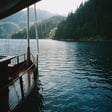The Amazon rainforest called to me for years before I finally answered. Last summer, I took the plunge into one of Earth's most magnificent ecosystems.
First Steps into the Unknown
Arriving in Manaus, Brazil's gateway to the Amazon, felt like stepping into another world. The humid air wrapped around me like a blanket as I prepared for my three-day "Adventure in the Wild" experience at an eco-lodge located about three hours from the city.
"You'll need these," my guide Magno said, handing me rubber boots and mosquito repellent. With more than 10 years of experience leading tours through Wild Amazon Tours, Magno's passion for the rainforest was immediately evident. "The Amazon isn't just a place—it's a living, breathing entity," he explained as we boarded a narrow boat that would take us deeper into the jungle.
The journey along the river revealed glimpses of local life—children waving from wooden homes perched on stilts, fishermen casting nets into the coffee-colored water. These weren't staged tourist attractions but authentic moments of Amazon life unfolding before my eyes.
Unexpected Encounters
My second day brought an experience I hadn't anticipated. While trekking through a section of dense jungle, we came across a family of howler monkeys. Their territorial calls echoed through the canopy, a primal sound that made the hair on my neck stand up.
"They're just letting us know we're visitors here," Magno laughed, seemingly unfazed.
Later that afternoon, during a fishing expedition, I tried my hand at catching peacock bass—a colorful predatory fish native to the Amazon Basin. I wasn't nearly as successful as the experienced anglers in our group, but the thrill of feeling something tug on my line in these ancient waters was reward enough.
Is the Amazon Really as Dangerous as People Think?
This question follows nearly every conversation about Amazon adventures. The reality? Yes and no.
The rainforest demands respect, not fear. While there are genuine hazards—from poisonous frogs to the occasional jaguar—most tourists who stay with reputable guides face minimal risks. The greatest dangers typically come from more mundane sources: sunburn, dehydration, or insect bites.
"Most problems happen when people ignore basic safety instructions," explained Roberto, another guide I met at the eco-lodge. "The Amazon isn't out to get you, but it doesn't make exceptions for carelessness either."
Living with the Rhythm of the River
What struck me most wasn't the wildlife (though spotting pink river dolphins was unforgettable) but how the Amazon's natural rhythms dictate everything.
Rising at dawn with the chorus of birds, sleeping as darkness fell around 6 PM—my body quickly synchronized with nature's clock. Without cell service or Wi-Fi, I found myself fully present in ways I hadn't experienced in years.
One evening, during a nighttime canoe expedition, our guide extinguished all lights. The darkness felt absolute until my eyes adjusted to reveal stars reflected in the water below, creating the illusion of floating through space.
The People of the Amazon
The indigenous communities living along the river banks maintain traditions that stretch back centuries. During a village visit, I watched as a local woman demonstrated how to extract natural rubber from a tree—a skill passed down through generations.
"We don't just live in the forest," she told me through a translator. "The forest lives in us."
This wasn't a rehearsed line for tourists; it reflected a profound relationship with the environment that most modern societies have forgotten.
My Amazon adventure wasn't just wild—it was transformative. In a world increasingly disconnected from nature, these few days reconnected me to something essential and reminded me that true adventure isn't about conquering wild places, but learning to exist within them.
Tags

About Isabella Montgomery the Author
With over 15 years of experience charting the world's most remote waters, Isabella Montgomery is a seasoned explorer and a leading voice in expedition-cruises, blending her nautical expertise with a passion for discovering untouched landscapes and diverse cultures.
Recommended Articles
How to Choose the Right Adjustable Bed This Black Friday
Discover how to choose the best adjustable bed this Black Friday with key factors like comfort, pricing, and features for a better sleep experience.
The Best Everyday Gadgets People Can’t Stop Using in 2025
Discover the must-have gadgets for 2025 that enhance convenience and connectivity in daily life, from smart home devices to fitness trackers.
The Expedition Cruises Taking Travelers to Places Planes Can’t Reach
Explore the allure of expedition cruises to remote destinations where planes can't reach, offering unforgettable adventures and unique experiences.
What Everyone Should Know About Amyloidosis in 2025
Discover essential insights about amyloidosis in 2025, including types, treatments, and the importance of awareness for improved patient outcomes.
Cruises That Take You to Places Few Folks Ever See
Embark on a journey that few have taken, as luxury expedition cruises unlock the gateways to unexplored destinations and promise unmatched adventures in pristine environments far from tourist crowds. Discover what makes these minor, intimate expeditions into remote places like the Antarctic or isolated Pacific atolls a transformative experience—one filled with close encounters with stunning wildlife, exclusive cultural interactions, and the chance to witness breathtaking landscapes most only dream of seeing.




